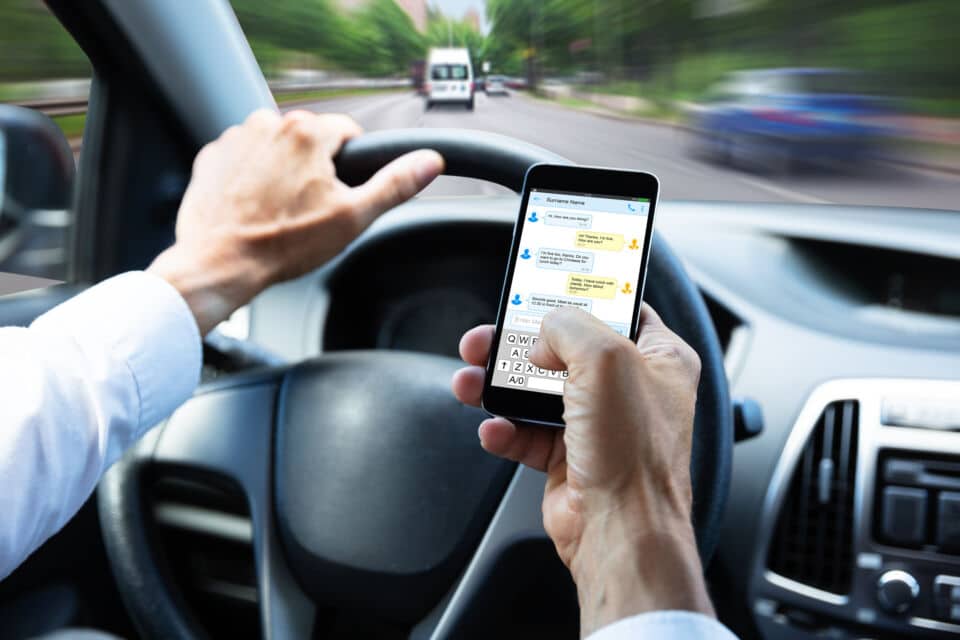Mobile devices have been paving a way into our lives since 1973, but it wasn’t until the mid-2000’s that mobile devices started changing the way we live and interact. Ever since, we’ve been attached at the hip, slowly forming a societal addiction of constant contact.
We never disconnect, even when we are behind the wheel, fostering a false perception of safe driving for future generations.

It takes 27 seconds for drivers to regain full alertness after texting.
A recent study showed that drivers use their phones during 88 out of every 100 trips. It takes 27 seconds for a driver to regain full alertness after making any voice-activated command, texting or any act that takes your attention away from driving.
We know distracted driving is bad, we read the statistics, we see the campaigns and we’ve maybe even signed a pledge or two. But traffic deaths are continuing to reach record highs and distracted driving is only getting worse.
So why aren’t we changing our driving behaviors?
It comes down to how we evaluate risks. We make our decisions by our knowledge and experiences. Think about it, how many times do we text, talk on the phone, or change the music with no consequence? We might have a few “close calls” that prompt us to sign that pledge to never text and drive again, but rarely does it impact us enough to continue safe driving habits.
Because that one close call doesn’t overpower our experiences of every other time we’ve been fine.
It’s these common-sense notions that make us believe we are going to be alright.

Distracted driving cuts our ability to react quickly in unpredictable situations.
We assume that we will see whatever is right in front of us when we are multi-tasking in our vehicle, but we won’t.
Working Memory is the part of our brain that consciously processes information, it governs everything we do in terms of learning new information. However, working memory has a limited capacity: Cognitive Load Theory. Cognitive load is measured by the number of elements we use in working memory that interact simultaneously. The more complex the task or subject, the more memory we need to learn, in return we use a higher amount of our cognitive load.
Learning how to drive involves a level of understanding on how several elements interact concurrently. How much do you need to turn the wheel, how much pressure for gas/brakes, each of these elements change if there is heavy/light traffic, different weather conditions, all requiring their own level of understanding, all being required to work together and processed at once.

Cognitive load theory suggests that working memory has a limited capacity.
As humans, we are always going to need to use a high-amount of our cognitive load to drive. There are always new elements to face every day while driving, increase in traffic, change in weather, requires us to re-focus how much pressure we need on that break, how far we should be behind the vehicle in front of us, etc.
Adding a secondary task while driving impairs our ability to drive, as one task is trying to compete for cognitive control: and in our societal addiction of constant contact, our tech prevails behind the wheel. These common everyday notions of evaluating our risks make us believe we can do it all, when we can’t.
We all miss a lot more than we care to think, even when it is right in front of us. In creating this perception, we’ve become a threat to ourselves and society, cultivating an environment that enables reckless driving behaviors.

National Teen Driver Safety Week starts on every October’s third Monday.
This perception is something we cannot simply ignore. Technology is rapidly advancing, population is booming, roadways are getting denser. In a sophisticated society, we must better understand ourselves to protect ourselves on the road. We need to rid ourselves of these everyday common-sense notions and realize that we can’t do it all, even behind the wheel.
No campaign, rule or regulation can change the societal norm we’ve created, we must change ourselves.
October 27th, 2018 ends Teen Driving Awareness week, but it shouldn’t be the end of your conversations with your teen about safe driving habits. It is important everyday to be safe on the road, and we can change the way we drive when we change ourselves.
This Teen Driving Awareness Blog Series, Features:
You can read these blogs anytime through our Social Media Platforms:
Read more information on how Laser Technology’s products assist law enforcement in enforcing distracted driving.
Sources: